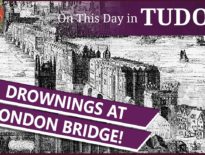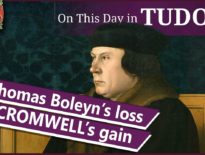On this day in Tudor history, on 8th July 1503, during the reign of King Henry VII, Thomas Boleyn, father of Anne Boleyn, left Collyweston in Northamptonshire to undertake an important job for the king.
He was to be part of a retinue escorting King Henry VII's eldest daughter, Margaret Tudor, to Scotland, for her marriage to King James IV.
Find out more about the retinue and journey in today's talk.
John Leland's full account can be read in Joannis Lelandi antiquarii De rebus Britannicis collectanea - https://archive.org/stream/joannislelandia01heargoog#page/n324/mode/2up, p. 265 onwards.
Also on this day in Tudor history, 8th July 1553, two days after her half-brother King Edward VI's death and one day after hearing news of his death, Mary, daughter of King Henry VIII and Catherine of Aragon, declared that she was Edward VI's heir and so was queen - Queen Mary I. Find out more in last year’s video:
Also on this day in history:
- 1536 – Death of William Wyggeston, merchant and benefactor, at Leicester. He was buried in the collegiate church of St Mary in the Newarke, Leicester, which was destroyed around 1548.
- 1540 – Abolition, by Henry VIII, of all heretical books and those containing errors.
- 1549 – The beginning of Kett's Rebellion. Robert Kett, a Norfolk farmer, agreed to lead a group of protesters who were angry with the enclosure of common land. The protesters marched on Norwich, and by the time they reached the city walls, it is said that they numbered around 16,000.
Transcript:
On this day in Tudor history, on 8th July 1503, during the reign of King Henry VII, Thomas Boleyn, father of Anne Boleyn, left Collyweston in Northamptonshire to undertake an important job for the king.
Thomas had been appointed as a member of a large retinue headed by his father-in-law, Thomas Howard, Earl of Surrey, to escort Henry VII’s daughter, thirteen-year-old Princess Margaret on her journey to Edinburgh, Scotland. Margaret was travelling to Scotland to prepare for her marriage to thirty-year-old King James IV of Scotland.
Margaret and her escorts had left Richmond Palace to travel to Collyweston, home of her paternal grandmother, Lady Margaret Beaufort, on 27th June 1503. They were accompanied that far by King Henry VII. The party spent eleven days there before starting their journey north. The journey took just over three weeks and stops included Grantham, York, Durham, Newcastle and Berwick. On 1st August, they arrived in Scotland and Margaret and the Scottish king were married at the Palace of Holyroodhouse, in Edinburgh, by the Archbishops of York and Glasgow on 8th August 1503. Thomas Boleyn was able to enjoy five days of celebrations before leaving Edinburgh for home.
Here is John Leland’s account of the journey:
“The Year of the Incarnation of our Lord God, a Thousand Five hundreth and Three, the Twenty-seventh Day of June, was transported out of his Manor of Richmond, the right high, right mighty, and right excellent and most Christian Prince, Henry by the Grace of God, King of England and of France, Lord of Ireland, the Seventh of his Name, and in the 18th Year of his reign, towards Coliweston, a Place of the right high and mighty Princess my Lady his Mother, accompanied of the right excellent Princess the said Margaret Queen of the Scots, his first begotten Daughter, And he being at Coliweston the 8th Day of the Month of July following, gave her Licence, and made her to be conveyed very nobly out of his said Realm; as more plainly shall be here following remembered, toward the right high and mighty and right excellent Prince James, by the Grace of God, King of Scots, in following the good Life, fraternal Dilection, and Intelligence of Marriage betwix him and the said Queen — The Holy Ghost, by his Grace, will maintain them in long Prosperity.
First, in the said Conveying, was ordained by the King, for Principal, the Earl of Surrey, Treasurer of England, very nobly arrayed, and all his Train. And also many Nobles, Lords, Knights, and Squires in his Company, together with my Lady his Wife, accompanied of many Ladies and Gentlewomen very nobly arrayed. Of the which it was a fair Sight, to the great Joy of all Nobless, there to be, to the End of the Performation of the said Marriage, and after the said Marriage made and accomplished, they returned.”
Leland gives even more details of the retinue and journey, plus wedding, and I’ll give you a link to read it online for yourself.
In The manuscripts of His Grace the Duke of Rutland: preserved at Belvoir Castle, Volume I, is a “List of persons who accompanied the Queen into Scotland” and Thomas Boleyn’s name can be found in the section “These be the names of them that were at the high feast with the Queen that be no knights”. He’s listed as “Master — Bolen, son and heir of Sir William Boleyn.” To be a part of this retinue was an honour for Thomas Boleyn.



Leave a Reply